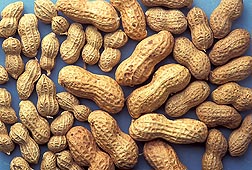This page has been archived and is being provided for reference purposes only. The page is no longer being updated, and therefore, links on the page may be invalid.
| Read the magazine story to find out more. |
|
|
|
|
Allergenic Properties of Proteins in Browned Peanuts
By Rosalie Marion Bliss
December 17, 2013
U.S. Department of Agriculture (USDA) scientists and colleagues have shed light on the molecular differences between raw and heat-treated nuts in terms of their inherent peptides that trigger a human allergic reaction. The study has helped to account in part for the increased allergenic properties observed in roasted peanuts, according to the researchers.
For the study, Soheila Maleki, a chemist with the USDA Agricultural Research Service (ARS) Food Processing and Sensory Quality Research Unit in New Orleans, La., worked with colleagues in Galveston, Texas and Beverly, Mass.
Previously, Maleki and colleagues had assessed the diagnostic reliability of standard peanut-allergy tests. She found that while people generally eat peanuts that have been heat treated (roasted or boiled), the extracts that are commonly used to diagnose peanut allergies are from raw peanuts. She hypothesized that raw peanut proteins undergo specific changes during roasting that may make them more likely to cause allergic reactions.
The major allergenic proteins (or allergens) of peanut are known as "Ara h 1," "Ara h 2," and "Ara h 3." For the study, the team looked into how the peanut-roasting process alters how well an allergic individual's immunoglobulin E (IgE) binds to peanut allergens.
The team compared the reaction by human IgE antibody to the heated and unheated forms of Ara h 1. The study showed that roasting-induced side reactions, such as browning, increased the amount of IgE that recognizes and binds to Ara h 1—when compared to the amount that binds to Ara h 1 from raw peanuts.
The study was published in Molecular Nutrition and Food Research.
ARS is USDA's chief intramural scientific research agency.
Read more about this research in the October 2013 issue of Agricultural Research magazine.

